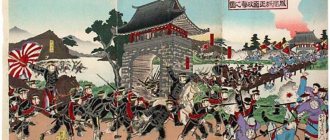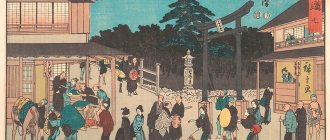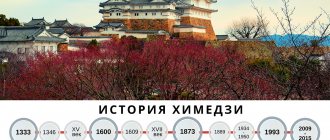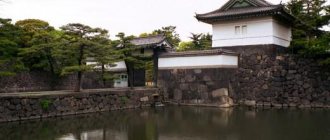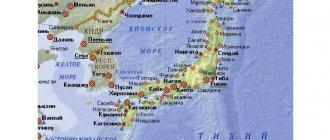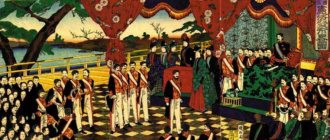Industrial engineering
After the Meiji Revolution, favorable business opportunities were created in the country. Only wealthy merchant and banking houses had the necessary capital, and they were in no hurry to invest in the construction of factories and factories. Habitual trading operations and usury brought them considerable income without additional effort and risk. In these conditions, the state played a special role.
The old road between Edo and Kyoto is one of the paintings from the series “53 Stations of the Tokaido Road”, 1833. Ando Hiroshige (1797-1858). Outstanding master of engraving. Influenced European painters, especially Van Gogh
The so-called “model enterprises” were built at the expense of the treasury. But they turned out to be unprofitable. Therefore, in 1880, most of the “model enterprises” were sold at low prices to private individuals, which, of course, stimulated entrepreneurial activity.
As a result, in a short period of time (70-90s of the 19th century), Japan acquired railways and telegraph communications, arsenals and a fleet, and modern industry. In three decades, the country has traveled a path that took European states several centuries to achieve.
Japan at the end of the 19th - beginning of the 20th century
On the path of fundamental changes
The coup d'état of 1867–1868 in Japan and the Meiji reforms opened the door for the creation of a market-based society in Japan. The restructuring of society in a European manner, while preserving the national traditions of the Japanese people, was the further main goal. Emperor Mutsuhito abolished laws and regulations that impeded the development of productive forces. Japan was open to all countries of the world. First of all, a single monetary unit was introduced.
Customs and other barriers on the borders of individual counties were removed. These measures opened up a broad path to trade and economic relations on a national scale. On the roads, guard posts were eliminated that controlled the migration of peasants to the cities, created to detain them and return them, because industry was interested in the influx of labor from the countryside. These events contributed to the development of the Japanese domestic market and the development of industrial sectors. In 1869, it was officially announced that all strata, i.e. feudal landowners, samurai, peasants, artisans and merchants, had equal rights.
Centralized government rule emerged throughout the country. A law on universal military service was adopted.
In 1871-1878, reforms were carried out in the field of agriculture, allowing the free purchase and sale of land, and it was allowed to plant any type of crops on purchased land. The tax in the form of a share of the harvest was replaced by a cash tax. A law was passed preventing the division of land into small plots.
The role of the state in industrial development
No matter how difficult the conditions were, market relations developed rapidly in Japan. Japan was the first in the East to take advantage of European practices, using advanced industrial technology that had been created over a long period of time in Europe and was handed over to Japan ready-made. The state followed the path of charity for the development of industry.
First of all, the textile industry developed rapidly in Japan. In 1890, its share was 45% of all industries. Over a quarter of a century, 1,300 industrial enterprises were built, which were initially leased to wealthy industrialists, and later began to be sold at half price and even for 10-15% of their original cost. There was a merger of banking and industrial capital. In terms of the pace of development of industry and capital, Japan developed ten times faster than Russia at that time.
Features of Japan's development
In Japan, monopoly capitalism was intertwined with the remnants of the feudal monarchy. In this respect, Japan was similar to Russia. Unlike England, France, and the USA, in Japan power was concentrated not in the hands of the bourgeoisie, but in the hands of the landowner bourgeoisie. Japan simultaneously began to rebuild its army and navy. The Japanese government paid special attention to the development of heavy industry. As a result, in the years 1900-1913, in terms of production, Japan was ahead of Italy and closer to France. Industry, trade and banks were concentrated in the country, and monopolies emerged.
Social life
In Japan, the development of capitalism occurred simultaneously with the separation of peasants from the land. Only 1/3 of the peasants who received land under the agrarian reform could keep it. Those who could not withstand the competition were forced to rent land. The rest, having moved to the city, became hired workers. Industrialists, using advanced production, brought the country to a new stage of development. The number of industrial enterprises increased every year.
The economic situation of the workers of these enterprises was very difficult, since wages were very low. The enterprises were not responsible for safety precautions. In addition, Japanese workers had neither political nor social rights. The working class began to organize into trade unions. The advanced layer of Japanese society fought for the creation of parliament.
Constitution of 1889
Economic reforms caused the growth of the bourgeoisie and its strengthening politically. The bourgeoisie began to lay claim to leadership of the state. The government decided to “give in.” And finally, in 1889, a new constitution was approved, based on the model of the Prussian constitution. A bicameral parliament was created in the country, consisting of an upper (House of Peers) and lower (House of Representatives) house.
The Constitution not only preserved all the prerogatives of the emperor, but also granted him even more rights and powers. For example, he retained the rights to convene parliament, open it, dissolve it, replace laws with a simple supreme decree, and be the Supreme Commander-in-Chief of the troops; he was given the right to declare war and conclude peace. According to the constitution, the Council of Ministers was accountable only to the emperor.
All decisions of parliament were to be discussed in the Privy Council under the emperor. The right to vote, which was established at the age of 25, was limited by property qualifications. Despite all the shortcomings, the very adoption of the constitution in such a country rich in medieval traditions as Japan was a great event.
Foreign policy
The impoverishment of the population complicated the sale of industrial goods. This situation pushed the ruling circles of Japan to seize the territories of neighboring states. Japan began to arm itself to achieve this goal. Japan's aggressive thoughts were directed towards Korea, China, and the Pacific Ocean. Soon Japan began wars of conquest. In 1879, Japan, despite resistance from China, captured the Ryukyu Island. In 1875, Japan separated the Kuril Islands from Russia, annexing Southern Sakhalin. In 1876, Korea was declared an "open" country to the Japanese. Japanese goods were sold duty free. Thus, Korea was removed from Chinese influence. The main goal was the annexation of Korea.
Japanese-Chinese war of 1894-1895
In 1894, Japan staged a palace coup in Seoul, created a Japanese-worshipping government, and disarmed the capital's garrison. These events led to the outbreak of the Sino-Japanese War. Transport ships of the Chinese navy were sunk. At the same time, Japanese troops, without declaring war, attacked Chinese military units located in Korea. In 1894, Chinese troops were defeated near Pyongyang. This paved the way for Japan to hegemony in the Far East. Japanese military forces, equipped with modern weapons, organized an attack from both land and sea, defeating the Chinese troops. In 1895, the Shimonoseki Treaty was concluded, according to which China recognized the independence of Korea, gave Japan the islands of Liaodong, Taiwan, Penghu (Pescador), and was also forced to pay a large indemnity to Japan.
According to the agreement, Japan received the right to build industrial enterprises for its trade in China. (China was declared “open” to Japanese industry and became a territory where Japanese entrepreneurs had uncontrollable control.) Japan’s goal now was to defeat Russia, its main rival in the Far East.
In 1895, Japan adopted a 10-year rearmament program. Japan achieved the conclusion of agreements ensuring the non-interference of great states in the event of a war with Russia. Thus, Russia was isolated before the inevitable war. Victory in the Russo-Japanese War of 1904 demonstrated Japan's military and economic power.
In 1910, Japan used military force to conquer Korea. The Japanese governor-general in Korea had unlimited power. To maintain colonial rule, Japan stationed large military forces in Korea.
Japan now turned its attention to China. The robbery of China by all European states and the United States encouraged Japan to also take advantage of the wealth of this country, which led to a deterioration in Japan's relations with the United States and England. Japan has become a dangerous adversary in the Far East. Thus, Japan was drawn deeper and deeper into the abyss of a new war.
Annexation (Latin annexio - accession) - annexation by force of all or part of the territory of another state. Contribution (lat. contributio) is an amount forcedly paid by a defeated state to the victorious state.
- Hello Gentlemen! Please support the project! It takes money ($) and mountains of enthusiasm to maintain the site every month.
